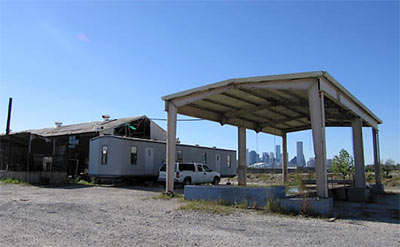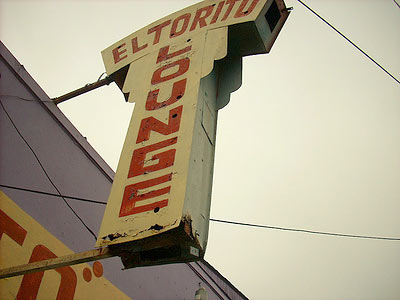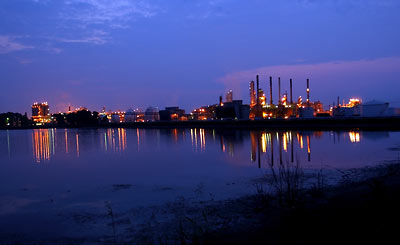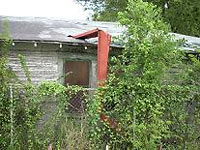And now, a rare look at the Second Ward’s indigenous Ship Channel dance ceremony, performed along the gentle banks of Buffalo Bayou and celebrating the bountiful fall harvest of crushed concrete.
- Tetsujin [Vimeo]
Video: Freneticore
And now, a rare look at the Second Ward’s indigenous Ship Channel dance ceremony, performed along the gentle banks of Buffalo Bayou and celebrating the bountiful fall harvest of crushed concrete.
Video: Freneticore
Houston ship pilot Louis Vest assembled this video from more than 2000 still photos he took on a 3 1/2-hour journey on a 600-ft.-long Panamax tanker navigating the Houston Ship Channel:
The ship was only moving at 5-6 knots for the first half of the trip and up to 10 knots in the open areas away from the docks. The journey begins just below the Port of Houston turning basin at the end of the channel and continues down to Morgan’s Point at the head of Galveston Bay. We still had 32 miles to go to get out to the pilot station in the Gulf of Mexico at that point.
Vest fastened his Nikon D700 to an outside rail and set it to take a photo every 6 seconds.
What does this trip look like in the daytime? Vest made a similar video last year (high-res version).
SOOT’S US Some public-health and environmental groups are complaining that Houston isn’t getting enough respect for the particularly fine quality of the air here, and are asking the EPA to give this city the recognition it deserves: “Houston’s concentrations of soot — a piercing mix of airborne matter from diesel exhaust, industrial flares and road grit, among other sources — exceeded the EPA’s yearly standards from 2005 to 2007, according to the most recent federal data available. . . . ‘Residents of Houston are breathing unhealthy levels of soot pollution,’ [the NRDC’s John] Walke said in an interview this week. . . . Soot has been a special concern near the Houston Ship Channel, which is home to heavy industry and a busy port. It’s the only place in Texas where the particulate-matter levels exceed the annual standard.” [Houston Chronicle]

Uh-oh. That trailer — behind the pole barn — on a former scrap yard — next to the Houston Biodiesel plant — on Buffalo Bayou — may look innocuous. But it’s the new temporary Houston outpost of Los Angeles’s Center for Land Use Interpretation. The CLUI is taking up a year-long residency at the Cynthia Woods Mitchell Center for the Arts at UH — but this is where our L.A. visitors will be camping out.
What does the CLUI do? Some sample CLUI projects:
In this exhibit, farm animals show us their point of view through wireless video cameras installed temporarily on their head and necks by virtuoso animal and plant videographer Sam Easterson. Easterson’s technology enables a cow, a pig, a goat, a chicken, a sheep, and a horse to guide us around their world; what they look at, what catches their attention, how they move through space, and how they relate to one another, on the farm.
You get the idea. CLUI’s front man is artist Matthew Coolidge, whose act often incorporates academic-sounding narrations of landscape slide shows.
Here’s video of part of a Coolidge performance at the Aurora Picture Show late last year:

Houston’s lone professional tourists, John Nova Lomax and David Beebe, stop off at the Brady’s Island in the Ship Channel midway into their latest day-long stroll . . . through this city’s southeastern stretches:
The air is foul here, and the eastern view is little more than a forest of tall crackers and satanic fume-belching smokestacks, sending clouds of roasted-cabbage-smelling incense skyward to Mammon, all bisected by the amazingly tall East Loop Ship Channel Bridge, its pillars standing in the toxic bilge where Brays Bayou dumps its effluent into the great pot of greenish-brown petro-gumbo.
While Brady’s Landing today seems to survive as a function room – a sort of Rainbow Lodge for the Ship Channel, with manicured grounds that reminded Beebe of Astroworld — decades ago, people came here to eat and to take in the view. This was progress to them, this horrifically awesome vista showed how we beat the Nazis and Japanese and how we were gonna stave off them godless Commies. As for me, it made me think of Beebe’s maxim: “Chicken and gasoline don’t mix.â€
More from the duo’s march through “Deep Harrisburg”: Flag-waving Gulf Freeway auto dealerships, an early-morning ice house near the Almeda Mall, a razorwire-fenced artist compound in Garden Villas, Harold Farb’s last stand, colorful Broadway muffler joints, the hidden gardens of Thai Xuan, and — yes, gas-station chicken.
“There is nothing else like the Southeast side,” Lomax adds in a comment:
I see it as the true heart of Houston. Without the port and the refineries we are nothing. The prosperous West Side could be Anywhere, USA, but the Southeast Side could only be here.
Photo of El Torito Lounge on Harrisburg: John Nova Lomax and David Beebe

Available now: A whopping 286.4 acres of lovely and historic waterfront property . . . inside Beltway 8! Easy freeway access. Close to . . . everything! Sealed bids are being accepted until April 7th.
Cushman & Wakefield, the real estate firm listing the site, said the property contains some of the last remaining large tracts of . . . land with water frontage in the Gulf Coast region.
This sounds almost too good to be true.
Photo: Georgia Gulf
 John Nova Lomax chronicles another pedestrian adventure with drummer pal David Beebe in Houstoned—this time through desolate pockets of Houston’s East Side. Their potion-and-perspiration-soaked journey begins at the southern end of the Fifth Ward.
John Nova Lomax chronicles another pedestrian adventure with drummer pal David Beebe in Houstoned—this time through desolate pockets of Houston’s East Side. Their potion-and-perspiration-soaked journey begins at the southern end of the Fifth Ward.
There, on the corner of Lyons Avenue and McKee, a dry-heaving stray dog in its death throes welcomed us to central Houston’s Chernobyl, a cursed warren of rusty train tracks, crumbling warehouses, and whole blocks that have reverted to wild coastal prairie.
Ruins of an entire neighborhood molder back here – unpainted shotgun shacks collapsing in on themselves scattered around a blocky brick building that looked like it was once a bar or liquor store. It had been stripped of all metal fixtures by street urchins and cut off from the electrical grid, but a sign in the window indicated it was for sale. “Call Bob,†it said. And evidently it was not so long ago a place of some importance, as a street teamer for a rapper named Marcelo had plastered a few promo posters on its door.
Next stop: Clinton Dr., where the “rank stench” of the 69th Street Wastewater Treatment Plant guides their path.
Lord have mercy on Clinton Drive. Save for a couple of islands of activity like the huge fenced-in KBR headquarters (which is rumored to be for sale), Clinton is now little more than a decrepit strip of ruined factories, warehouses fast crumbling into rubble, and decaying 1950s office buildings with broken windows and mold-stained walls.
It reminded me of 19th Century British gadfly William Cobbett’s description of the village of Deal, Sussex: “Deal is a most villainous place. It is full of filthy looking people. Great desolation of abomination has been going on here; tremendous barracks, partly pulled down and partly tumbling down and partly occupied by soldiers. Everything seems upon the perish. I was glad to hurry along through it…â€
It wasn’t always such. From the Ship Channel’s opening until the advent of containerized shipping in the early ‘80s, Clinton and surrounding streets were bustling by day and by night, dotted with rice beer-soaked bars with names like the Cesspool, the Worker’s Bar, the Seafarer’s Retreat, the Mermaid Café, Tater’s Last Chance and Dottie’s Snug Harbor.
In those days, it could take a week to unload a cargo ship, and for much of that time, sailors were free to roam the port, dine in the restaurants, carouse in the bars, and find companionship where they may. The same went for the thousands of shore-based workers – the mechanics, channel pilots, stevedores, and tug boat crews.
Neighborhood on the waterfront: Coulda been a contender.
Photo: David Beebe and John Nova Lomax